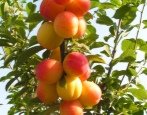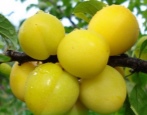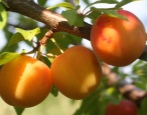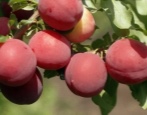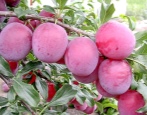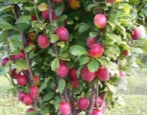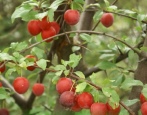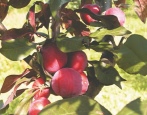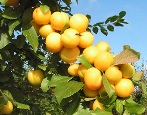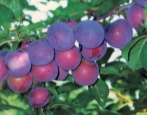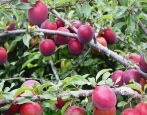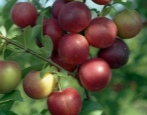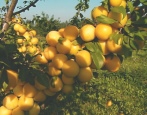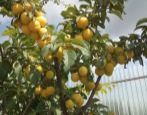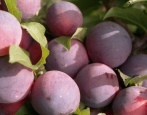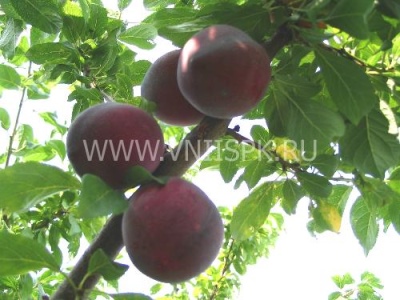
- Authors: G.V. Eremin, S.N. Zabrodina, A.V. Isachkin (Crimean experimental breeding station of the All-Russian Research Institute of Plant Industry named after N.I. Vavilov)
- Appeared when crossing: Abundant x Hybrid 2 (Cherry Cultural red x apricot)
- Year of approval: 2002
- Growth type: vigorous
- Ripening period: average term
- Self-fertility: self-infertile
- Fruit size: very large
- Yield: high
- Appointment: for canning, for fresh consumption
- Transportability: good
Cherry plum compote is one of the favorite delicacies of children. The Globus variety grows well on a personal plot and gives a stable harvest, but for this it needs good care.
Description of the variety
The described tree is included in the group of hybrids. This stone fruit culture was bred in the Crimea. The variety is distinguished by its high productivity and excellent fruit taste.
The globe is a vigorous plant, its crown is wide-round, not too dense.
Fruit characteristics
The described variety has large fruits with a red-violet skin. Inside, the flesh is yellow, rather dense.
The bone separates remarkably. Cherry plum of this variety demonstrates excellent transportability. The fruits are suitable for preservation, they are very tasty and fresh.
Taste qualities
The fruits of the Globus cherry plum are sweet, there is a slight sourness. There is a scent.
Ripening and fruiting
Globus ripens by the end of August. Blooms in early May. Begins to bear fruit 3 years after planting.
Yield
The yield is high.
Growing regions
This variety of cherry plum is grown in the North Caucasus and in the Lower Volga region.
Self-fertility and the need for pollinators
This variety of cherry plum is self-fertile, since it has only male flowers.
Growing and care
Cherry plum is not too demanding on the soil, it grows well both on wet soils, with a high location of water in the soil, and on dry ones. This tree does not really like acidic garden lands, although it is quite tolerant to the pH level. The globe withstands drought and frost well, only the absence of snowfall during cold winters can cause freezing of the root system.
Grows best in a place protected from the wind and well lit. The plant rarely suffers from diseases and pests. This variety can grow singly or in a group.
Cherry plum can be planted both in autumn, starting from the second half of October, and in spring, from March to April. But it is still better to carry out the procedure before the start of frost, then the soil conditions ideally match the planting. In this case, plant survival is better, since the air temperature is lower and there is more water in the soil. Landing should only be carried out on a cloudy day.
For planting, a hole is dug, organic fertilizer is placed on the bottom. Compost works well, but rotted manure can also be used. It is advisable to cover them with a layer of fertile soil.
Before planting, it is recommended to place the seedlings in water with a growth stimulator and hold there for several hours. Such a simple procedure will increase the chance of the Globus taking root at the landing site. The tree must be placed at the same depth as it grew in the nursery. After planting, a small groove should be formed around the seedlings and the cherry plum should be watered abundantly.
The globe is often planted in two rows. There are 4 seedlings per square meter.If the cherry plum is planted on a hedge, then it is better to prune and turn the Globe into low but wide bushes. The average annual growth of seedlings is 80-100 cm.
Immediately after planting, the tree must be pruned to a height of 20-25 cm, due to which the crown will be thicker in the future. Pruning is done twice a year: in June and August. In the first season after planting, it is necessary to remove the emerging lateral shoots, cut the rest to a length of 70-90 cm. Thus, the first tier of the Globe crown is formed. In subsequent years, pruning is limited to crown pruning and pruning of branches that grow inward. This procedure should be performed every 2-3 years. Root suckers growing at the base of the trunk are removed annually.
After planting the seedling in the ground in the first year, fertilizers are not applied, because top dressing was used during planting. Trees older than two years are fed in the spring. Before the tree gives color, ammonium nitrate is added (90 g per sq. M), and at the beginning of the summer period potassium (up to 50 grams), superphosphate (up to 180 g) are given.
In the spring, the old bark is removed and the trunk is treated with 3% copper sulfate. In April, you can carry out preventive treatment against insects.
In the first year of the cherry plum life, the Globe needs abundant watering. From the second year, the frequency of hydration decreases. If there is a lot of moisture and nitrogen in the soil, the plant begins to grow, and the risk of aphid infection increases. In this case, the shoots ripen poorly, are prone to aging. In August, soil moisture ends. It is undesirable to water for the winter.
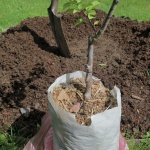
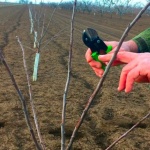
Disease and pest resistance
Cherry plum of this variety demonstrates good resistance to various types of diseases, but this does not mean that it is worth abandoning preventive treatment with fungicides and insecticides.
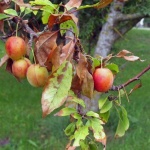
Requirements for soil and climatic conditions
The globe has an average winter hardiness, but even during the flowering period, it does not fall off from frost.


